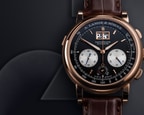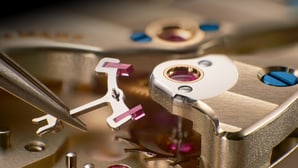The jumping seconds mechanism assures excellent legibility. It moves the sweep-seconds hand by exactly 60 steps per minute; it is part of a long-standing tradition at A. Lange & Söhne. The first concept of a pocket watch with a seconde morte (French for jumping seconds) is attributed to Ferdinand Adolph Lange and dates back to the year 1867. In his design, the seconds mechanism was positioned between the plates. Only ten years later, the seconds wheel train was positioned above the three-quarter plate; Lange’s sons Richard and Emil filed a patent application for this arrangement. The advantage of this configuration was that the watchmaker could remove the seconds mechanism without taking the movement apart.
Control of seconds jump
As in the historic mechanism, a flirt and a star were the elements that controlled the seconds jump, the conversion of the six semi-oscillations of the balance into one hand step per second. Together with the escape wheel, the five-point star – located on the escape wheel arbor under a transparent jewel bearing – rotates about its own axis once every five seconds. After each full second, one of the tips of the star liberates the tensioned lever arm, which watchmakers refer to as the “flirt”. It then swiftly rotates through 360 degrees before it is stopped by the next tip of the star. This rotation is transferred to the central seconds hand via the seconds wheel train, causing it to advance to the next marker.
The start/stop mechanism for the jumping seconds
The very first Lange pocket watch with jumping seconds already allowed the large sweep-seconds hand to be started and stopped with a pusher. This process was controlled by a column wheel. The seconds mechanism with a jumping hand in the calibre L1924 of the 1815 “Homage to Walter Lange” – visibly located on the three-quarter plate – operates according to the same principle described in patent No. 182 dated 1877. If the pusher is actuated while the central seconds hand is running, the V-shaped lever released by the column wheel blocks the flirt including the entire seconds mechanism while the wheels of the movement continue to run.
The connection of the movement with the seconds mechanism is established by a stop-click mechanism on the arbor of the respective third-wheel pinion. The ratchet wheel is firmly connected with the pinion; with two stop clicks and their springs, it transfers torque to the jumping third wheel. The pallets of the stop clicks engage with the ratchet wheel and thus allow power to flow from the mainspring barrel to the seconds mechanism. When it is stopped, the wheels of the seconds mechanism are blocked but the pallets of the stop clicks alternately drop off from the teeth of the ratchet wheel that continues to turn slowly. This ingeniously simple design makes it possible to power the movement and the jumping seconds with a single mainspring barrel.
Explore further




Exclusive insights into the world of fine watchmaking
Experience A. Lange & Söhne’s fascinating heritage, unique stories and exquisite timepieces by subscribing to our newsletter.
How can we be of service?
Whether you are in search of a specific model, have questions out of interest or need a service request for your timepiece – we are delighted to help you. We are at your service by phone, email or in one of our boutiques.









